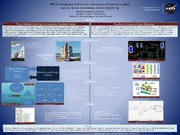
NASA Technical Reports Server (NTRS) 20160006892: Physics Simulation Software for Autonomous Propellant Loading and Gas House Autonomous System Monitoring PDF
Preview NASA Technical Reports Server (NTRS) 20160006892: Physics Simulation Software for Autonomous Propellant Loading and Gas House Autonomous System Monitoring
Physics Simulation Software for Autonomous Propellant Loading and Gas House Autonomous System Monitoring Bjorn Constantine Regalado Reyes University of Texas – Pan American Mentors: Dr. Fernando Figueroa and Mark Turowski Abstract Physics Simulation Software for Autonomous Propellant Loading Gas House Autonomous System Monitoring Kennedy Space Center (KSC) is developing a mobile launching system with autonomous propellant loading capabilities for liquid-fueled The High Pressure Gas Facility (HPGF) stores and distributes hydrogen. nitrogen, helium and high pressure air. The hydrogen and nitrogen are rockets. An autonomous system will be responsible for monitoring and controlling the storage, loading and transferring of cryogenic stored in cryogenic liquid state. The cryogenic fluids pose several hazards to operators and the storage and transfer equipment. Constant propellants. The Physics Simulation Software will reproduce the sensor data seen during the delivery of cryogenic fluids including valve monitoring of pressures, temperatures and flow rates are required in order to maintain the safety of personnel and equipment during the positions, pressures, temperatures and flow rates. The simulator will provide insight into the functionality of the propellant systems and handling and storage of these commodities. The Gas House Autonomous System Monitoring software will be responsible for constantly demonstrate the effects of potential faults. This will provide verification of the communications protocols and the autonomous system control observing and recording sensor data, identifying and predicting faults and relaying hazard and operational information to the operators. and monitoring functions. Introduction Cryogenic Fluids “Cryogenic Fluids may loosely be defined as those fluids whose normal boiling temperatures at atmospheric High Pressure Gas Facility pressure are below 273K.” [1] This Facility stores and distributes hydrogen, nitrogen, helium and high pressure air. These gases are required to be in a pressurized environment and kept at cryogenic temperatures Autonomous Propellant Loading Provide automated handling of propellants for mobile launching capability G2 Application of a Liquid Nitrogen System Objectives • Design and develop a G2 workspace to Physics Simulation Data • Simulate sensor data such as pressures and represent the Liquid Nitrogen system Software temperatures based on mathematical models components Monitoring and Control • Respond to commands by changing • Use G2’s real-time processing capabilities • Pressure Sensor Systems simulation state and rule-based expert system for fault • Temperature Sensor • Ensure proper communications between detection • Valve Feedback Commands control software and hardware Autonomous Control and ISHM Integration Architecture Approach Subscriber Object DATA FIX • Utilize Integrated Systems Health Management Simulation Controller • Utilize Object-Oriented VALVE DEFAULT (ISHM) concepts [3] Programming with an emphasis • Utilizing ISHM toolkit developed in on reusability partnership with General Atomics • Employ Design Patterns to avoid RULE QUEUE • Object-Oriented Programming MIRROR ROUND common pitfalls Commands Publisher Object • Implement standardized Data, Information and Knowledge Architecture communication (Space Packet SECOND LIMITS Protocol) [2] Telemetry Results Strategy Design Pattern Publisher-Subscriber Design Pattern • Created a Domain Model for Liquid • Successful Integration with Monitoring and Control Systems Nitrogen Process Equipment • Used static code analysis tools to analyze code for correctness • G2 Workspace created for Liquid Nitrogen and identify and correct known bugs System • Verification and Validation performed in multi-system testing • Integrated into overall monitoring application environment Integrated Nitrogen Domain Model Module Simulation Sample Output References 1) Weisend, J. G. Handbook of Cryogenic Engineering. Philadelphia, PA: Taylor & Francis, 1998. Print 2) United States of America. National Aeronautics and Space Administration. Council of the Consultative Committee for Space Data Systems. SPACE PACKET PROTOCOL. Blue Book ed. Vol. Issue I. N.p.: n.p., n.d. CCSDS 133.0-B-1. CCSDS. Web. 11 June 2015. 3) Figueroa, Fernando, and Kelvin Melcher. Integrated Systems Health Management for Intelligent Systems. Proc. of Infotech at Aerospace, St. Louis, Missouri. Print. Publication # goes here, bottom right. Get Publication Number here>>>> https://ssccampus.ssc.nasa.gov/sdns/main/request.asp
